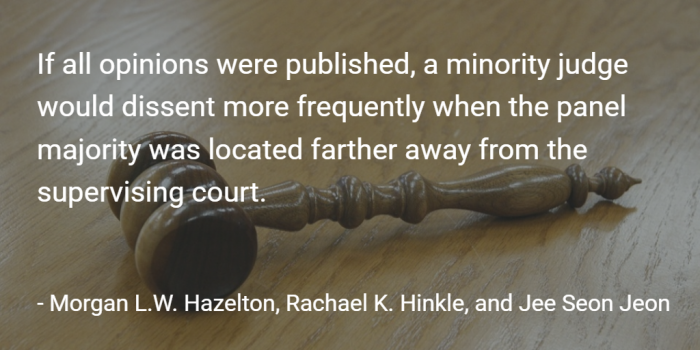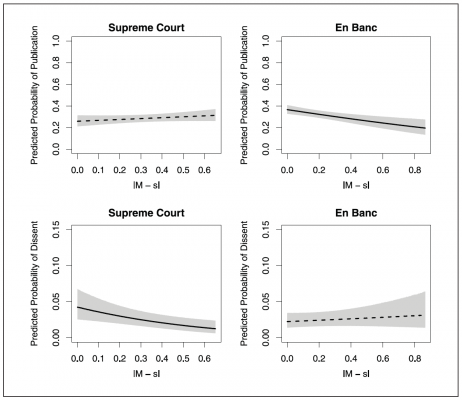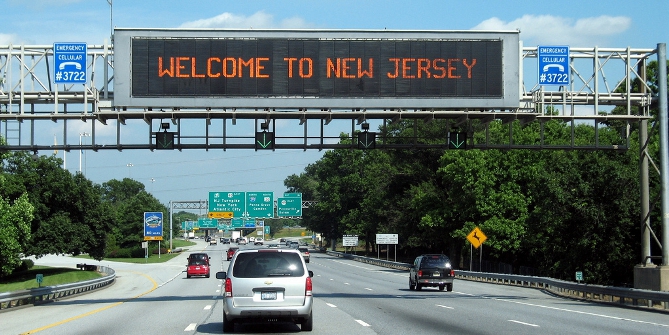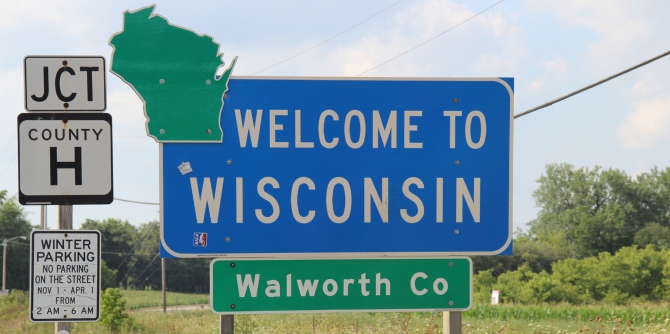

 Not all legal cases establish a legal precedent – federal circuit court appeal opinions often go unpublished and thus only apply to the dispute in question. In new research, Morgan L.W. Hazelton, Rachael K. Hinkle, and Jee Seon Jeon find that the decision whether or not to publish such opinions can have an influence on whether a judge issues a dissent from the majority. If the circuit court is substantially different ideologically from a higher court, judges can pre-emptively silence a dissenting opinion by deciding that it will not be published, thus negating the chance that their decision will be reviewed by a higher court.
Not all legal cases establish a legal precedent – federal circuit court appeal opinions often go unpublished and thus only apply to the dispute in question. In new research, Morgan L.W. Hazelton, Rachael K. Hinkle, and Jee Seon Jeon find that the decision whether or not to publish such opinions can have an influence on whether a judge issues a dissent from the majority. If the circuit court is substantially different ideologically from a higher court, judges can pre-emptively silence a dissenting opinion by deciding that it will not be published, thus negating the chance that their decision will be reviewed by a higher court.
A single rule can have far-reaching effects. The designated hitter rule makes American League baseball distinct from the otherwise-identical game in the National League. The introduction of mandatory state-appointed counsel for criminal defendants changed the face of criminal law. Likewise, in federal intermediate appellate courts (also called circuit courts), there is a simple housekeeping rule that has surprisingly far-reaching effects. As a result of this rule, a single judge who disagrees with two others can potentially limit the influence of the majority’s decision to the case at hand, thereby preventing their legal reasoning from having an effect in any future cases.
Every litigant in the federal system has a right to at least one appeal. The circuit courts must hear all of these appeals. As a result, they resolve a vast number of routine cases as well as cases with novel legal issues which require the judges to develop law for their circuits. Historically, printing space was limited so courts created systems for determining which cases should be published based on their relative novelty and importance. This system also limited the number of cases that attorneys would have to research to a more reasonable number. Only published cases were legally binding in future cases. Although all opinions are now available electronically, circuit courts have generally continued the practice of only designating those opinions that have been specifically designated as “published” as binding authority. Thus, unpublished opinions in most circuits only resolve the dispute between two parties without further legal significance.
Panels of three judges resolve nearly all circuit court cases. Scholars have recognized that in the case of disagreement, the minority judge is far from powerless. The hierarchical structure of the judiciary can offer a dissenting judge leverage over her peers in the majority. Decisions of a panel can be reviewed, and potentially overturned, by two sources: the entire circuit sitting en banc or the Supreme Court. A judge with the minority can under some circumstances persuade his colleague to change their votes by threatening to write a dissenting opinion, which would increase the probability that the panel’s opinion will be reviewed. The more plausible it is the minority judge can convince a supervising court to review and reverse a decision, the more power that judge wields.
The bargaining dynamics among circuit judges have primarily been studied without regard to the fact that circuit judges generally chose which opinions will have binding legal force in the future. Introducing this element changes judges’ anticipated behavior in important ways because appellate review of unpublished opinions is exceedingly rare. This fact stems, at least in part, from the fact that unpublished cases generally do not affect the development of law, and, therefore, are not worth the supervising courts’ limited time. This fact provides majority judges with a counter to a minority judge’s threat of dissent. They can simply leave an opinion unpublished to minimize the probability of review rather than changing their votes to prevent the minority judge from dissenting. Would-be dissenters are also discouraged from incurring the costs of dissenting in an unpublished case due to the decision’s very limited impact.

We developed a formal model of interactions between a panel minority and panel majority that incorporates the possibility of both the minority judge choosing to dissent and the panel majority choosing whether or not to publish the opinion. This model generates empirical predictions about publication and dissent. As the ideological distance between the panel majority and potential supervising court increases, both publication and dissent become less likely. The first prediction is very intuitive. When a panel majority has a different viewpoint than the supervising court, publishing fewer cases is a rational strategy for reducing the likelihood of review. The second prediction, however, is the opposite of what one would predict without taking publication into account. If all opinions were published, a minority judge would dissent more frequently when the panel majority was located farther away from the supervising court. In such circumstances, the minority judge would be in a better position to make a convincing argument about the necessity of review. Once the publication decision is added into the mix, the model predicts the opposite pattern. Dissent is less likely exactly when it poses the greatest threat. This occurs because the majority recognizes the threat and preempts it by not publishing the opinion. Although this requires sacrificing influence over future legal development, it preserves the ability of the majority to both attain their preferred case outcome and minimize the possibility of review.
So what happens when the rubber meets the road? Is there any evidence that these theoretically interesting patterns actually exist in the real world? There is some evidence of each pattern predicted by the formal model, but each emerges in a different context. To look for these patterns, we examine all search and seizure opinions from circuit court panels between 2005 and 2008. We examine the data using each potential supervising court, en banc and the Supreme Court, in turn. The results (shown in Figure 1 below) provide evidence that an increasing distance between the panel majority and the supervising courts leads to the predicted decrease in publication as expected, but only in the en banc model. There is also evidence of the predicted decrease in dissent, but only in the Supreme Court model.
Figure 1 – Search and seizure opinions from circuit court panels by probability of publication and dissent, 2005 – 2008

Note: This graph provides the predicted probability of publication (top panels) and dissent (bottom panels) at different values of |M−s| (the absolute value of the difference between the majority and supervising court) from the minimum to the maximum observed in the data for both Supreme Court and en banc review. The shaded regions depict the 95% confidence interval around the predicted probabilities. Solid lines denote patterns that support our hypotheses while dashed lines indicate an absence of the relevant hypothesized relationship.
The empirical evidence, while not conclusive, is certainly suggestive. The insights generated by the formal model should not be ignored. Accounting for this simple rule has important implications. And the federal circuit courts are not the only courts that select a subset of their opinions for publication. This practice also followed in many state courts. Traditionally, the lack of accessibility to unpublished decisions posed substantial barriers to empirical examination of those opinions. But with increasing availability of these decisions from widely-available electronic sources, these barriers are crumbling, offering opportunities to obtain key insights such as the one provided here. Minority judges can potentially shape legal development by preventing a panel majority from being a binding precedent.
Featured image credit: Shawn Calhoun (Flickr, CC-BY-NC-2.0)
Please read our comments policy before commenting.
Note: This article gives the views of the authors, and not the position of USAPP– American Politics and Policy, nor of the London School of Economics.
Shortened URL for this post: http://bit.ly/29gOkBq
_________________________________
 Morgan L. W. Hazelton – Saint Louis University
Morgan L. W. Hazelton – Saint Louis University
Morgan L. W. Hazelton is an assistant professor of political science and law (by courtesy) at Saint Louis University. Her work focuses on judicial politics, judicial hierarchy, litigation, and information theory, and has appeared in the Review of Law & Economics, American Political Research, and Global Jurist.
 Rachael K. Hinkle – University at Buffalo, SUNY
Rachael K. Hinkle – University at Buffalo, SUNY
Rachael K. Hinkle earned her Ph.D. in Political Science from Washington University in St. Louis and her J.D. from Ohio Northern University. She is currently an assistant professor in the Department of Political Science at the University at Buffalo, SUNY. Her research agenda focuses on judicial politics with particular attention to gleaning insights into legal development from the content of judicial opinions through the use of computational text analytic techniques. This work is informed by her experience clerking for the Honorable David W. McKeague in the U.S. Court of Appeals and the Honorable Robert C. Broomfield in the U.S District Court and has appeared in the American Journal of Political Science and the Journal of Politics.
 Jee Seon Jeon – Florida State University
Jee Seon Jeon – Florida State University
Jee Seon Jeon is an assistant professor of political science at Florida State University. She received her Ph.D. in Political Science from Washington University in St. Louis. As a formal theorist and comparativist, she studies dynamic bargaining models, concentration of political and economic power, and voting models. Her work has appeared in Electoral Studies, Journal of Elections, Public Opinion and Parties, and Public Choice.












